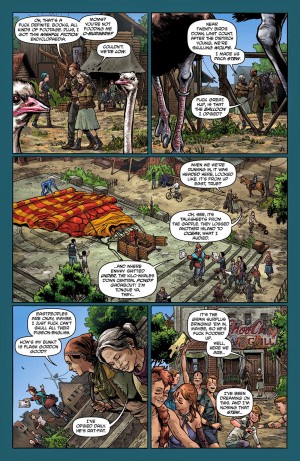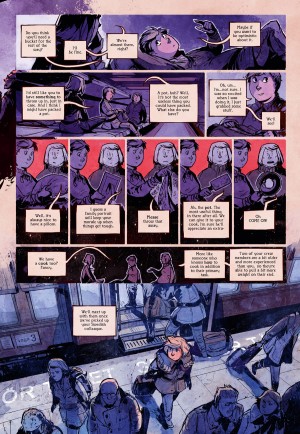Previously, I reviewed The Sculptor and Beautiful Darkness, and then Curveball and Nimona. There’s also a summary post, including my list of notable SFF graphic novels of 2015.
 Crossed + One Hundred, by Alan Moore and Gabriel Andrade.
Crossed + One Hundred, by Alan Moore and Gabriel Andrade.
Although he has created original works, Alan Moore is the comics medium’s greatest reinterpreter of existing creative properties. The British writer first became famous in the U.S. for his reinvention of DC Comics’ Swamp Thing title, in a run that both completely reinvented the character and incorporated all the character had been before. Other major Moore reinterpretations include Miracleman, The League of Extraordinary Gentlemen (featuring, among other famous characters, Captain Nemo, The Invisible Man, and Jeckyl/Hyde), and Lost Girls (an erotic comic featuring grown-up versions of Alice of Wonderland, Wendy from Peter Pan, and Dorothy of Oz). My favorite Moore book, From Hell, is based on already-existing Jack The Ripper lore. Even Watchmen, Moore’s most famous original work, started out as reinventions of the Charlton superhero characters.
Moore returns to the reinvention game with Crossed + One Hundred, a new graphic novel set in Garth Ennis’ awful Crossed universe. Crossed was Ennis’ attempt to make the zombie genre more disturbing and violent: the premise is that most of humanity population gets infected with a mysterious disease that turns them into torturing, murdering, rape-happy idiots. In many ways Crossed is the comics equivalent of the Saw movies; cheap, gratuitous, and compelling.
 Moore and his collaborator Gabriel Andrade get away from all that by leaping a hundred year into the future. A century after civilization ended, the remaining humans have banded into settlements; the “Infected,” being idiots with no instinct for self-preservation, have mostly died out. The protagonist, Future Taylor, has never seen an Infected firsthand; she’s an “archivist” who takes expeditions into the wreckage of the collapsed human civilization, attempting to regain lost knowledge. All the characters speak in a version of English that has evolved in the century since civilization collapsed – but not so far that they can’t be understood. (By the time I was at the end of the first chapter, I could read the odd dialog – “See it is, Planboss Monroe didn’t want infecteds audying in and getting learn on our sweep” – effortlessly). The language is just one of many convincing details of life a hundred years after civilization’s collapse.
Moore and his collaborator Gabriel Andrade get away from all that by leaping a hundred year into the future. A century after civilization ended, the remaining humans have banded into settlements; the “Infected,” being idiots with no instinct for self-preservation, have mostly died out. The protagonist, Future Taylor, has never seen an Infected firsthand; she’s an “archivist” who takes expeditions into the wreckage of the collapsed human civilization, attempting to regain lost knowledge. All the characters speak in a version of English that has evolved in the century since civilization collapsed – but not so far that they can’t be understood. (By the time I was at the end of the first chapter, I could read the odd dialog – “See it is, Planboss Monroe didn’t want infecteds audying in and getting learn on our sweep” – effortlessly). The language is just one of many convincing details of life a hundred years after civilization’s collapse.
Of course, this is a Crossed comic – so I don’t think it’s giving away much to say that violence, and tragedy, lurks in this story. But this is the first Crossed story I’ve read that seems to believe that humans actually have some worth. And although there are depictions of sick violence, including sexual violence, that’s not the focus. The most notable sex scene is an explicit sequence featuring Future and her lover – and, in what might be a first in the Crossed universe, it’s just joyful, ordinary, eagerly consented-to sex.
I haven’t opsied – sorry, seen – Brazilian artist Gabriel Andrade’s work before, but he’s marvelous on this project. His ability to draw fully realized environments, including crowd scenes that must have taken him forever, is essential to making the + One Hundred world feel satisfyingly detailed and fleshed out, whether it’s on a wooden ship, in the lush greenery that’s overgrown human cities, or in the wreckage of Elvis’ Graceland mansion. Andrade draws in a conventional realistic comics style – with more European than American influence, hence the detailed environments – but he does it well, and he concentrates on good storytelling rather than flashiness.
I understand that there is now a sequel to Crossed + One Hundred, by a different creative team (although working with world notes left by Moore). Nonetheless, this book tells a complete story that comes to a satisfying (if downbeat) ending.
From a diversity perspective, most of the characters in this book are white (there are two Black characters, one of whom is a major character), which makes sense, since it’s set in the remains of Tennessee. A couple of characters, including the main character’s lover, are Islamic (a liberalized Islam seems to be the only surviving human religion). I’m honestly not sure if the main character is white or Latina. There are plenty of female characters of various ages in this book, who are shown as being equal participants in society.
 Stand Still, Stay Silent volume 1, by Minna Sundberg. (Disclosure: I’m still reading this comic.)
Stand Still, Stay Silent volume 1, by Minna Sundberg. (Disclosure: I’m still reading this comic.)
This is another post-apocalyptic graphic novel, but it could not be less like Crossed + One Hundred. It begins with a series of vignettes, set in the Nordic countries, showing the rapid collapse of society under the onslaught of a deadly plague. (Although the comic doesn’t show the sickness itself, instead focusing on various people fleeing the sickness.) Ninety years later, Iceland – which closed its borders (sometimes violently) to protect itself from the plague – holds the largest surviving community of humans. There’s magic (including mages, and intelligent cats).
The story involves a crew of explorers – “a poorly funded and terribly unqualified crew, but a crew nonetheless” – who set out from Iceland to explore the remaining world. This is a comic for the worldbuilding fans; for the folks who want to see maps of the known world, and costume designs of Mages from each culture. And despite the underlying tragedy, there’s a laid-back wackiness to this series which is just plain fun.
 Also fun is Sundberg’s art, which is unique and charming, and features some really striking uses of limited color palettes. She’s especially adept and drawing rains, storms, ships and the sea, all of which show up a lot in Stand Still, Stay Silent. And her faces, which are in a style of drawing that I think owes more to children’s illustration than to mainstream comics, are very animated and appealing to look at.
Also fun is Sundberg’s art, which is unique and charming, and features some really striking uses of limited color palettes. She’s especially adept and drawing rains, storms, ships and the sea, all of which show up a lot in Stand Still, Stay Silent. And her faces, which are in a style of drawing that I think owes more to children’s illustration than to mainstream comics, are very animated and appealing to look at.
On the down side, Stand Still, Stay Silent is quite slow-paced – one of my housemates tells me that he gave up on it for that reason. And this is one of the whitest comics I’ve ever read; I didn’t notice a single non-white character, not even in the backgrounds. (In real life, Iceland is mostly white, but not 100% white). Female characters in SSSS fulfill important roles in the story and are treated as equals in the society.
I should mention that, although a paper version of SSSS volume one was self-published, it is currently out of print. However, you can buy an ebook version, and the entire (still ongoing) story is posted as a webcomic.



The “whiteness” of SSSS is something that has been noted on before, but this brings up an interesting question: is there actually a diversity problem in webcomics in general to the same extence that there is one in movies?
The impression that a heavy reader of webcomics (anywhere between 50 and 80 series followed on a regular basis) gets it that this is not the case, that a very significant part, if not a majority of webcomics feature ethnically diverse casts, and thus it is less pertinent in that case to single out the ones that don’t than it is for movies, since those are not part of an actual problem — the diversity in webcomics is there and easily accessible, and webcomics that happen to have all white casts are not significantly overrepresented to a degree that hinders that global diversity.
(Leaving aside whether in the specific case of SSSS, the all white cast is justified by the post-apocalyptic scandinavian setting — this is not just the Nordic countries, this is the Nordic countries where most of the important urban centers (where immigrants and their offprings predominently live) have been wiped out, survivors being mostly from isolated countryside towns, and where presumably isolated survivors from different ethnic background have assimilated and intermarried with the rest of the population)
This is an interesting point. I’d be really interested in seeing someone trying to conduct a systematic study of how diversity in webcomics compares to diversity in traditionally-published comics.
Pingback: 2015 Science Fiction and Fantasy Graphic Novel Recommendations, part four: Summary | Alas, a Blog
Short of a real study, here’s some eyeballing: 80+ webcomics taken from the front page of the site Topwebcomic (where people vote for their favorite comic) and 60+ webcomics taken from personal reading lists, classified into three categories, “All White Cast” (self-explanatory), “Diverse Cast” (for comics with an ongoing story, at least one secondary [not background] character of a different ethnicity from the rest of the cast; for gag comics without continuity, frequent occurence of minority characters) and “Ambiguous” (style of drawing or nature or universe obfuscate ethnicity [frequent for comics with a large non-human cast]).
(Are excluded from the count comics where all or almost all the cast is non-human and doesn’t look human enough for human ethnicities to be relevant, notably furry webcomics)
Full list: http://pastebin.com/J5prCrJE (there are likely errors, since the majority of these comics have not been thoroughtly read)
This gives 42 comics with an all white cast, 64 comics with a diverse cast, and 24 ambiguous comics. Adopting a pessimistic reading with counting all the ambiguous comics as “all white” and allowing for a 10% margin of error in favor of the “all white” category, the final count would be 72 all white comics and 58 diverse comics so a proportion of roughly 55% to 45%.
This is likely too small a sample to be fully representative of webcomics as a whole, though it does rather speak positively of *popular* webcomics.
Pingback: Pixel Scroll 3/26/16 Who Killed Morlock Holmes? | File 770